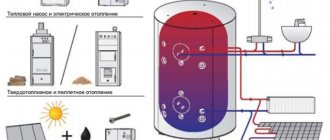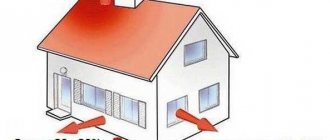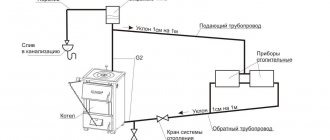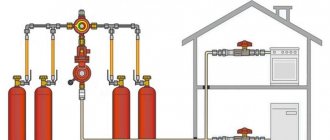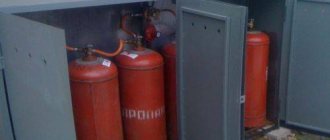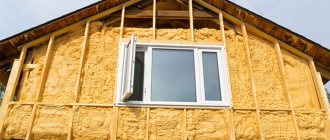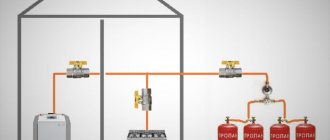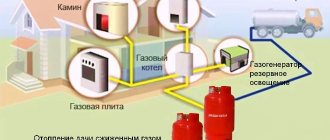Electricity is traditionally the most affordable source of energy in the Russian Federation, and gas is the cheapest. Therefore, in their absence, heating a private house without gas and electricity becomes problematic. The main methods of heating a home are passive house systems or boilers using wood or diesel fuel. Let's consider the possible methods in more detail.
Alternative cottage heating
Heating options
The maximum discomfort during the operation of the building is caused by the lack of gas and electrical energy. Therefore, the owner needs not only to heat a private house without gas and electricity, but also to generate 2-10 kW of electricity for domestic needs. There are not many power supply options:
- generator - usually diesel with the maximum possible resource;
- thermoelectric generator – generates current from thermal energy, the leading manufacturer is Kryotherm.
Diesel generator
There are many more ways to heat a building, from a classic wood-burning air heating stove to alternative sources (heat pump, solar panels). But for high efficiency of alternative heating systems, for the operation of pumps and compressors in their composition, electricity is also required.
Solid fuel boiler
Heating of a private house without gas and electricity can be organized using solid fuel boilers. The most comfortable operation is ensured by long-burning modifications with natural draft:
- loading into them is carried out from below, the afterburning chamber is located at the top;
- after heating the lower firebox to 200 degrees, a mechanical damper blocks the access of air to the combustion chamber;
- pyrolysis (release of flammable gases) from smoldering coals begins inside it;
- gas enters the upper chamber and burns to release energy;
- the coolant is heated in the jackets or pipes passing inside the boiler;
- passes through the registers, giving off heat, and is fed to the next cycle.
Construction of a solid fuel diesel generator boiler
In top-loading pyrolysis boilers, fans are used; in bunker boilers, a worm gear must be rotated to regularly feed pellets into the combustion chamber. Therefore, this equipment can only operate with a generator.
Use of liquid fuel
Another way to implement heating is to heat a private house without gas or electricity using liquid fuel boilers. The cheapest energy source is diesel fuel, but diesel boilers have a significant drawback - the fuel must be stored in compliance with the fire safety of the home; during combustion, a characteristic odor is formed that does not dissipate.
Diesel generator
Air heating is provided by stoves or fireplaces. Classic stoves are:
- Russian – heating + cooking;
- “Dutch” - mounted in an opening, heats several adjacent rooms;
- universal – cooking on removable hob rings + room heating.
Air heating with stoves
They are made of brick, steel, and equipped with chimneys, ensuring the safety of passage points through the floors and roofing. Devices for generating electricity from heat from Kryotherm are easily integrated into the furnaces. In addition, the manufacturer produces sauna stoves that allow you to illuminate the room until the walls of the heating device cool down.
Biofireplace for heating a room
Helpful information! The safest is a bio-fireplace, which does not require a chimney. By making adjustments, you can achieve a minimum operating budget; combustion does not produce harmful products, soot, or soot.
Passive house
Heating of a private house without gas and electricity can be organized by “passive house” systems. In this case, modern thermal insulation materials are used, which reduce energy consumption to 7 - 10%.
Passive house system
In other words, such a dwelling must have enough thermal energy generated by the family in the process of life. The building has compact dimensions, an external insulation contour, a layer of thermal insulation under the foundation and blind area. The following must be taken into account:
- cardinal directions - living rooms from the south, functional rooms protect them from the north;
- wind rose - heat loss is absorbed by verandas and kitchens on the windward side of the site;
- layout - should ensure high-quality air exchange by recuperators.
Related article:
Table of thermal conductivity of building materials. Have you ever thought about how well your home is insulated? Or maybe you are just starting to build a home? In any case, you need to become familiar with the concept of “thermal conductivity”.
In addition to the above measures, alternative energy sources (thermal + electric) are used:
- solar water heater;
Solar water heater
Related article:
Solar batteries for the home: cost of the kit. Until recently, solar panels seemed like something futuristic. However, they are already available to everyone. Don't believe me? Read our detailed publication.
- geothermal heat pump.
Geothermal pump
Related article:
Heat pump for home heating: prices. This type of heating is gaining popularity every year. Let's calculate how much such a system will cost and how profitable it is.
There are “active home” systems that, in addition to reducing heat loss, are capable of generating additional heat accumulated by the central home network. The main disadvantage is the high installation budget for such equipment and long payback periods.
Helpful information! When choosing a “passive house”, ventilation is forced. Instead of window supply valves, airtight double-glazed windows are installed. Ventilation is carried out only by recuperators.
Candle heater
The candle flame shines quite pleasantly, but trying to warm up with it seems crazy. Meanwhile, just as a light source, a candle is an extremely wasteful device. But as a room heater it can be useful. Under a number of conditions.
Californian inventor Doyle Doss and his company DOSS Products offer the original Kandle Heeter system, that is, the “Candle Heater”.
This strange-looking candlestick, its creator claims, can be indispensable during a power outage. Its height is about 23 and its width is about 18 centimeters.
And from its appearance, the inverted pot above the candle attracts attention. The main highlight of the system is hidden in this pot (and in a “past life” it was a flower pot)
This pot is not simple, but composite. It is made of three pots of different diameters, nested one inside the other and connected by a long metal bolt, on which a whole bunch of washers and nuts are strung (fortunately, the pots usually already have holes in the bottom).
An ordinary candle, burning in a room, produces, as it seems, very little heat. But the point here is that its hot “exhaust” simply goes up and quickly evaporates with the ventilation.
Meanwhile, the energy reserve in a candle is not so small. Moreover, with the hot flow of combustion products, most of its energy content leaves, and only a smaller part is converted into light.
The labyrinth cap above the flame collects energy and carefully stores it, heating up quite strongly (the central rod is especially hot). And then this heat is slowly transferred to the air by the entire surface of the ceramic radiator.
The pots also help trap soot from the fire, which helps keep the ceiling clean.
The inventor emphasizes that one such device will in no way save you in the winter when the heating and electricity are turned off, but, on the other hand, it is better than nothing at all.
By the way, clay pots are certainly not bad, but they have low thermal conductivity and it is better to replace them with a similar metal structure, for example, from cans of different sizes or old Soviet cans for bulk products, who else keeps these as a memory :))
Operating principle, device, pros, cons
Thus, for heating a private house without gas and electricity, the simplest schemes are:
- stove + bio-fireplaces – the first heating device heats the kitchen and one adjacent room, allows you to prepare food, bio-fireplaces in the remaining rooms improve the interior, are used as needed, the problem of electricity is solved with Cryotherm devices;
Biofireplace models
- boiler - long-burning solid fuel with natural draft or diesel fuel.
Hot water circulates inside the heating circuits of a private house without gas or electricity, using standard registers. When choosing a pellet bunker boiler, which allows the device to operate on one filling for 4 to 11 days, electricity will be required to drive the dosing equipment (worm auger). Therefore, to generate electricity, the following are used:
- Cryotherm devices - hung on the hot walls of boilers/furnaces or placed inside the firebox, heating circuits, generate a current that is sufficient for lighting and electric drives;
Cryotherm device
- solar panels - mounted on the roof of a home or utility room, they charge batteries, the energy of which is consumed as needed.
Solar battery
Heat pumps take heat from natural sources (geothermal soil heat, above-zero groundwater temperature, warm air energy). The circuits of heat exchangers, within which inert gases (usually freon) circulate, are placed horizontally below the freezing mark or vertically inside the wells, which allows maintaining the working area of the site.
Operating principle of the heat pump
For your information! Any heat pump will require electricity to run. Another thing is that energy consumption is low; a low-power diesel generator will cope with the task.
How to heat a house using a heat pump
A heat pump is an alternative to heating a house if there is no gas or wood. This method is deservedly considered the best for heating a country cottage or country house. The installation allows you to obtain heat using natural resources: seas, lakes, underground sources, land and even air (read: “An air heating unit is a good heating option”). Heat pumps are in little demand among consumers, since they are expensive and installation is quite expensive.
Tips, recommendations
When choosing heating with boilers for a private house without gas or electricity, you need to consider the following factors:
- propane-butane mixture in cylinders or bottled for filling a gas tank is five times more expensive than natural gas from centralized systems;
- the electricity generated in generators should be used only for equipment and lighting; electric convectors should not be connected to these networks;
- diesel fuel is four times more expensive than coal, the boiler room has a characteristic smell;
- peat and pellets made from pressed sawdust are one and a half times more expensive than coal;
- Firewood is the cheapest energy source, but long-burning boilers require high quality wood (low humidity + hardwood without resinous substances).
Comparison of energy costs
There are household wind generators from domestic manufacturers GRC-Vertical, Wind Energy, Sapsan-Energia with a capacity of 1 - 35 kW, consisting of a mast, blades, turbine, rotating mechanisms, fastening elements, control automation. They produce 12 - 24 V, the energy is accumulated in 50 - 100 Ah batteries, which are enough for a cottage.
Household wind generator
The disadvantage of the technology is the complex design, since forecasting windy weather is impossible in principle. The payback period for solar collectors is very long, so the accumulated electricity is usually not used for heating needs.
Thus, there are quite a lot of options for heating a home in the absence of gas/electricity. The choice of the best one depends on the specific operational and climatic conditions of the region.
How to heat a house without gas using electricity
One of the options for heating a house without gas is heating using electricity. The homeowner, depending on his financial capabilities, can choose from a wide range of equipment and installations that provide heating, whatever suits him most. Electric heaters are produced in the following types:
- "warm floor" system;
- fireplaces;
- infrared heating;
- fan heaters;
- convectors.
The currently popular “warm floors” are often used to supply heat to residential premises on an ongoing basis if heating a country house without gas is required. They can be mounted not only in the base of the floor, but also in special panel walls. But such systems are installed exclusively during the construction of buildings. As for fan heaters and fireplaces, such devices are used when it is necessary to provide the house with additional heat.
How to light the stove
You can drown anything that burns. The classic option is wood and coal. However, the following sources of thermal energy have also been used in the furnace at all times.
Dung
Dung is completely dried cow dung. It burns well and leaves almost no ash. Horse manure can be used for the same purpose. By the way, there is no smell from such fuel.
Peat
Peat, or more precisely, peat briquettes. In terms of calorific value, it is somewhere between wood and coal. Briquettes burn in an already heated firebox. This means that you need to first heat the stove with wood, and then add briquettes.
More precisely, the toxicity of peat smoke can be equated to the toxicity of firewood. Only peat produces more ash and smoke. You can only talk about the benefits of using peat if you have the opportunity to buy it at a low price. In all other cases, it is better to use firewood and coal.
Firewood
Firewood is considered to be the cheapest fuel. However, it is not always possible to agree with this statement. Even if a ton of firewood is cheaper than a ton of coal, you need to compare based on the final result.
Coal
It is best to use coke. Coal burns for a long time, and good coked coal is also hot.
If you use black coal with low ash content and high calorific value, then one measure of coal can provide as much heat as 3-5 such measures of firewood. The only argument against coal is its high ash content.
More
There are other firewood substitutes. For example, seed husks or corn cobs. Both burn well, but not for long, and without intense heat. However, these types of fuel should not be considered seriously.
Thus, among all types of solid fuels, it is worth choosing firewood and coal. Moreover, precisely in combination. Firewood is good for lighting the stove, and coal is good for long and slow burning.
Brick stoves or Russian stoves
In its classic form, the Russian stove is a miracle of engineering soap with a very efficient heating system. Not only did the stove heat the entire hut, it was also a multifunctional kitchen, a heated bed and even a bathhouse.
In modern conditions
Making an ancient Russian stove modern is quite simple:
- If one of the sides is built into the wall separating one room from another, then two rooms will be heated. However, the stove has four sides.
- If you manage to build a stove into two walls of two different rooms, then you can heat almost the entire house.
- If the house is large, then you cannot do it with just one heat source - you will have to make a system of pipes and batteries with a water heating element.
A Russian stove differs from a simple brick stove in its size and the absence of a stove bench. A brick oven has great inertia - it takes a long time to heat up, but it also takes a long time to cool down.
To make the cooling process last longer, there is a damper system that retains hot air. However, it is in this system that the biggest danger of the stove lies - if the damper is closed ahead of time, then carbon monoxide from the firebox will not go into the chimney, but into the house.
Price
The cost of building a brick stove depends on a number of factors: firstly, on the size, secondly, on the selected materials, and thirdly, on the wages of the stove maker. Moreover, the work costs the most.
So, if the stove maker charges moderately, and you are not going to decorate the stove with marble and ceramics, then you can spend 20-60 thousand rubles. Whether it is expensive or not - everyone evaluates it differently. However, you should take into account the fact that the stove will last for decades.
